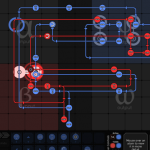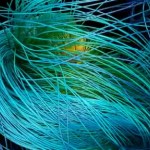Web 2.0, New Media, and Gadgets
A few months ago I got an email from Zachtronics, creators of the Codex of Alchemical Engineering, about the new indie game called SpaceChem. It was billed as "an obscenely addictive, design-based puzzle game about building machines and fighting monsters in the name of science." What's not to love?
Here's a preview. . .
Science!
Game reviewer Quintin Smith loved it:
SpaceChem is a game where you build fabulous contraptions. It's about getting stuck into a massive puzzle, laughing at the optimism of what's expected of you, and then finally applying what might be the finishing touch to your…
Recently, Scienceblogs/National Geographic decided it would no longer host pseudonymous science bloggers. As a result, many of my former colleagues have left. I think this decision was wrong. Read on for my reasons.
One: simple fairness. Several well-established pseudonymous bloggers had been active here for years. While it's perfectly reasonable to set up a media site from scratch and institute a "no pseudonymous blogging" policy at that time, it's quite another to change the rules and evict members of an established community. It violates my sense of fairness; it's why we usually expect…
This video from Xperia Studio very effectively conveys how data visualization can both leverage and challenge our conceptions of "reality." The night sky we've seen since childhood, like everything else we see, is just a tiny slice of the spectrum - only what we can perceive with our limited physiology. An app that lets us "see" otherwise invisible wavelengths is not merely a prosthesis that cleverly enhances our sensory perceptions, it's a tool to expand our worldview, by reminding us that what we see is only a limited subset of the whole: we could as easily see quite a different world, and…
Photo of Vermont highway courtesy of Kyle Cornell
Last week, I had my long-awaited vacation semi-ruined when, thanks to Hurricane Irene, my flight back from the West Coast was cancelled. I had to rent a car and drive across the country in a rush - not my favorite way to spend three and a half days. But based on what I saw passing through New York, and what I've heard about the damage in Vermont, I can't complain: flooding has overturned homes, isolated entire towns, and destroyed everything some families own.
Vermonters are a notoriously self-sufficient bunch, and I haven't seen that much…
Gold Cortex
16 x 20, 2010
Greg Dunn
I used to have a beautiful gold Japanese folding screen, which was purchased by my great-grandmother's feisty sister on a trip in the 1920s. I loved the gold patina and the surprisingly modern impact it had on my wall. At the moment, it's loaned to a friend, but looking at Greg Dunn's artwork, I couldn't help but be reminded of the best aspects of my screen: the gold leaf, crisp black patterns, and way that the scene seemed half natural, half abstract.
The biggest twist Greg, a 6th year graduate student in neuroscience at the University of Pennsylvania,…
"Magnetic Field Outflows from Active Galactic Nuclei"
P.M. Sutter, P.M. Ricker, H.-Y. Yang, G. Foreman, D. Pugmire/ORNL
Wired has an article/webgallery of award-winning scientific visualizations which is worth a lunchtime visit. (Having trouble with Wired's interface? The videos collected there are the winners from SciDAC 2011's "Visualization Night" challenge, so you can also just watch them here.)
These visualizations are not your usual public-facing educational animation. Rather, they're just what you'd see at a scientific meeting - dry, functional, aimed at a specialist audience, and…
From the Smithsonian, a short video about using technology to virtually reassemble ancient art from fragments long carried away and dispersed:
Majestic sixth-century Chinese Buddhist sculpture is combined with 3-D imaging technology in this exploration of one of the most important groups of Buddhist devotional sites in early medieval China. Carved into the mountains of northern China, the Buddhist cave temples of Xiangtangshan were the crowning cultural achievement of the Northern Qi dynasty (550-77 CE). Once home to a magnificent array of sculptures--monumental Buddhas, divine attendant…
This 1967 IBM propaganda film, "Paperwork Explosion," couples an eerily deadpan refrain of "more time on paperwork," with a creepy pseudo-country neighbor* urging us to embrace Progress.
The film's frenetic soundtrack and abrupt transitions embody the familiar hysterical nervousness of an increasingly automated era, while striving the whole time to convince us that technology will relieve the pressures of the modern workplace, allowing us to "think" instead of "work". Looking back, of course, it's clear that technology instead cranked the pressure up. If writers like Nicholas Carr are to be…
One of the much-hyped benefits of social networking is that it provides a way to get personalized recommendations about businesses from a wider network. If I want to tell the world that the coffee place in my neighborhood has the best cappuccino this side of Seattle, I can do that (and it does)! That's what Yelp is for - right?
Well, not quite. I realized a while ago that my reviews don't show up on Yelp anymore. They've been "filtered" from the site, like thousands of other users' reviews. Yelp won't explain why (they say if they did explain the algorithm, it would allow merchants to game…
Physicists are ontological detectives. We think of scientists as wholly rational, open to all possible arguments. But to begin with a conviction and then to use one's intellectual prowess to establish support for that conviction is a methodology that really has worked for scientists, including Deutsch. One could argue that he dreamed up quantum computing because he was devoted to the idea that science can explain the world. Deutsch would disagree. In "The Fabric of Reality," Deutsch writes, "I remember being told, when I was a small child, that in ancient times it was still possible to know…
If you haven't already seen the Photopic Sky Survey, you really should. Nick Risinger toured the world's least light-polluted sites to photograph and stitch together this 37,440 exposure, 5000 megapixel image of the night sky. I honestly don't think I've ever appreciated the sheer number of stars out there as much as I did this morning, zooming in on Nick's amazing panorama. Someone really needs to mash this up with a Carl Sagan monologue or something, because anything I could say about our relative insignificance in the universe would be inadequate.
I was playing The Fracking Song last night about midnight, and my boyfriend was grooving to it. At the end he asked, "what was that about?" "Uh. . . fracking."
"Which kind of fracking?"
Yes, we are a BSG household.
Anyway, it may be an explainer, but it's actually quite a nice little piece of music too. And I'm a sucker for good typography any day.
Is your fracking attention span longer than 2:33? Then go dig around in ProPublica's fracking investigation. "The Fracking Song" is by members of Jay Rosen's NYU graduate journalism class. Nice work, guys!
Now this is just cruel: yesterday the Cambridge Science Festival kicked off - a week of science, sciart, sci-journalism and sci-education activities at MIT, Harvard, the Museum of Science, and surrounds. Am I going to be hanging out all day with my fellow-geeks in the sun (which finally came out a few days ago, right on cue)? No! Because I have to write two final papers. (At least they're about sci-law. . . )
Anyway, don't be like me. If you're in the Cambridge/Boston area, have a life and check out the Cambridge Science Festival schedule. There are talks, performances, screenings, panels,…
Recently, IP scholar and government corruption critic Larry Lessig gave a talk at CERN in which he talked about the mismatch between the goals of copyright and scientific publishing. I was excited to watch it, but . . . well, I fell asleep partway through. (It's a long talk.)
I haven't been well lately (thus the lack of posts) so I should probably thank Professor Lessig for the much-needed nap. It honestly wasn't because the video was boring - I love Lessig talks and their typographic design, and if it was boring, I wouldn't be sharing it here. But prior to the nap, I was a little troubled…
From Linda Holmes, a poignant post about how the deluge of information makes it impossible to scratch the surface in a single lifetime:
there are really only two responses if you want to feel like you're well-read, or well-versed in music, or whatever the case may be: culling and surrender.
Culling is the choosing you do for yourself. It's the sorting of what's worth your time and what's not worth your time. It's saying, "I deem Keeping Up With The Kardashians a poor use of my time, and therefore, I choose not to watch it." It's saying, "I read the last Jonathan Franzen book and fell asleep…
How do you get kids to master science, math, and engineering? Ask them to make a video game that teaches it to other kids. Check it out:
One of these kids wrote a video game to teach himself his multiplication tables. Another calls his elementary school cousins his "user test group." I clearly am way, way, older than I ever realized I was. I learned to "program" by writing long strings of BASICLOGO commands for a "turtle" which could. . . drumroll. . . draw lines. Pathetic.
Video: winners of the 2010 national STEM video game challenge, "a competition to motivate interest in science,…
Calling all dataviz peeps: you know you want to meet Stephen Colbert. All you have to do is win DonorsChoose's version of the Netflix Prize.
It's a contest called "Hacking Education". DonorsChoose explains, "We've opened up [our] data, and invite you to make discoveries and build apps that improve education in America. Help to shape your school system's budget by revealing what teachers really need. Build the first mobile app for hyper-local education philanthropy. We've got a list of suggestions to help get you thinking."
Good luck!
While we're on the bioanimation topic, I recently heard from Jess at Nervous System, who sent me links to some animations of their new jewelry line, hyphae, "growing" in virtual space. Check it out:
Hyphae - growth of the Vessel Pendant from Nervous System on Vimeo.
They explain,
Hyphae is a collection of 3D printed artifacts constructed of rhizome-like networks. Inspired by the vein structures that carry fluids through organisms from the leaves of plants to our own circulatory systems, we created a simulation which uses physical growth principles to build sculptural, organic structures.…
Remember when I said more bio grad students should play with coding and modeling? Here's an example of what I mean. Laurence Frabotta directed me to this animation by phylogeneticist/bioinformatics programmer Liam Revell, an assistant professor at U Mass Boston, who used the statistical package 'R' to write a short code generating all possible bifurcating and multifurcating phylogenetic trees for a set of taxa. Apparently there are 2,752 for seven taxa (I have to take his word for it, my basic math skills have long since escaped me) and this animation runs through all of them. It's not…
In addition to all the obvious reasons, tech blogger Jillian York recently noted that some web filters use comments, and links in comments, to categorize sites as pornography. This means even a blogger who diligently refrains from any, er, PhysioProfisms, can be classed as offensive and filtered based on comments alone. York explains how recently her blog was blocked by Websense:
My assumption was that their automated system was based on keywords, and that my blogging about Helmi Noman's paper ("Sex, Social Mores, and Keyword Filtering: Microsoft Bing in the 'Arabian Countries'") had caused…



